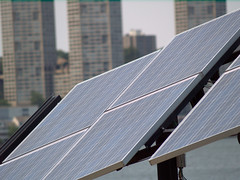The New York Times published story today on the National Parks Service’s response to an inquiry about Nantucket Sound, finding that is is eligible for listing in the National Register of Historic Places. The site has not yet been listed, and if it were it could further hinder the beleaguered renewable energy development, but it would not be an insurmountable impediment. Continue reading
Category Archives: Massachusetts
Candlelight Vigil at Senator Kerry’s Office
 Massachusetts’ citizens will be gathering together tonight in solidarity with the citizens of those nations that will be first to face the impacts of climate change. The candlelight vigil is part of 350.0rg’s call for a science-based international climate treaty and effective U.S. legislation to get us back below 350 ppm of CO2 in the atmosphere.
Massachusetts’ citizens will be gathering together tonight in solidarity with the citizens of those nations that will be first to face the impacts of climate change. The candlelight vigil is part of 350.0rg’s call for a science-based international climate treaty and effective U.S. legislation to get us back below 350 ppm of CO2 in the atmosphere.
The program includes compelling speakers invoking the moral imperative for world leaders to act, a group photo documenting the event, and development of photo messages to President Obama calling for action. People will be meeting at Cardinal Cushing Park in Boston, located at the intersection of Cambridge Street and New Chardon Street (across the street from Senator Kerry’s office at One Bowdoin Square). The vigil is being held from 6:00 – 7:30pm with a post-vigil gathering at the Beantown Pub.
This strategic location is aimed to reach Senator Kerry, who will be America’s principal negotiator at the United Nations Climate Change Conference held this month in Copenhagen. It is not clear what will come out of the negotiations, as there is the potential for developing countries to walk out due to resistance from developed nations providing retribution for past carbon pollution. The US has backed away from taking any action until spring, though the US has established the U.S. Center at the Copenhagen Conference. 350.org has called for vigil’s across the globe, urging for a climate treaty that is line with the latest sciuence and protects the most vulnerable countries to safeguard their very survival.
To rsvp for the climate vigil go to: www.facebook.com/event.php?eid=186121428405&ref=
For more info: email 350Boston@gmail.com
Climate Sleep-Out in Boston pays off
 For the past seven weeks, college students from around the region have been camping out on Boston Common on Sunday nights calling for Massachusetts to run entirely on clean energy by 2020. After a final, snowy sleep-out last Sunday, the demands of The Leadership Campaign were answered, sort of.
For the past seven weeks, college students from around the region have been camping out on Boston Common on Sunday nights calling for Massachusetts to run entirely on clean energy by 2020. After a final, snowy sleep-out last Sunday, the demands of The Leadership Campaign were answered, sort of.
On December 7, state officials introduced a bill to create a task force charged with proposing ways to get Massachusetts to 100% clean electricity by 2020.
The resolution seems like a nice way of saying we’ve heard you, now bugger off, but then again Massachusetts relies on coal for only 25 percent of its electric power (about half the national average) and has set a goal of 20 percent renewable electricity production by 2020.
I wonder what it would take for the state to get to 100 percent “clean electricity”—the Leadership Campaign seems to include fossil fuel plants that use waste heat capture and recycling in its definition of clean—by 2020.
Image Credit: Ian Maclellan for The Leadership Campaign
Mass renewables redux
 Cape Wind is still embroiled in politics, and CommonWealth Solar may soon be. The state’s grant program to promote solar energy is effectively bankrupt. On the plus side, if you already have a photovoltaic installation or other renewable energy system, you can now sell much more electricity back to NSTAR.
Cape Wind is still embroiled in politics, and CommonWealth Solar may soon be. The state’s grant program to promote solar energy is effectively bankrupt. On the plus side, if you already have a photovoltaic installation or other renewable energy system, you can now sell much more electricity back to NSTAR.
Sustainable (sea)food

New Scientist has an interesting article on the “Five eco-crimes we commit everyday.” Most are not very surprising, but the details are interesting, such as the fact that the western world wastes one third of its food!
Egregious as this waste is, the means used to produce and procure much of our food is more important. To this end, Slash Food has a brief post highlighting some better seafood choices including local award-winning business Aqua Australis.
Also released this past week, a study of food sustainability revealing that, surprise of surprises, the devil is in the details and “food miles” are an over-simplification.
Sizing up the senatorial candidates
In case you had to work yesterday, and were unable to make the Environmental League of Massachusetts‘ Democratic Senate candidate forum1 at BU, we’ve managed to scrounge up some coverage of the debate. Although a live webcast was available, an archived stream does not seem to be however, NECN has a few minutes of video along with their summary. WBUR also has a brief, if blasé write-up, whereas the Globe’s article at Boston.com includes some colorful quotes.
The Massachusetts League of Environmental Voters—not to be confused with ELM above, but co-sponsors of yesterday’s debats—has compiled a set of resources which you may find useful in evaluating which candidate to vote for.
P.S. If you’re not yet registered to vote, applications must be postmarked today in order to vote in the primary; if you register as a member of a party holding one.
1. ELM is working to arrange a similar session with Republican candidates.
Dollars 4 Dishwashers
There were a number of issues with the “Cash for Clunkers” program, including excessive paperwork and bureaucracy, poor planning, etc. Even though the program was touted as having environmental benefits, and not merely another handout to big business, there were questions as to the significance of these impacts before the program ended. Soon there will be another rebate program, which has thus far received little attention, and has apparently been dubbed by some “Dollars for Dishwashers” to disparage it. The outcome of this enery star appliance rebate “program” will be more interesting to watch since each state is responsible for developing a plan to disperse its awarded funds. Massachusetts was awarded $6 million by the DoE, and rebates should become available in 4 to 6 weeks. Keep your eyes open, and get ready to build a super-efficient fridge… I know I’ll be bugging my landlord soon enough.
It’s a Thirsty World…
 Living in Massachusetts, it is easy to take water for granted with an average rain fall of 45 inches per year. While 2009 might turn out to be an above average year for rainfall, overall the region is expected to experience more frequent drought episodes. But despite the impacts from climate change and falling water tables from unsustainable suburban developments, Massachusetts is lucky in comparison to many other places across the globe like India, Australia, Mexico, Las Vegas, and the story of the week– Greece.
Living in Massachusetts, it is easy to take water for granted with an average rain fall of 45 inches per year. While 2009 might turn out to be an above average year for rainfall, overall the region is expected to experience more frequent drought episodes. But despite the impacts from climate change and falling water tables from unsustainable suburban developments, Massachusetts is lucky in comparison to many other places across the globe like India, Australia, Mexico, Las Vegas, and the story of the week– Greece.
In a warming world, India which has been self sufficient for thousands of years is now deeply challenged on how to feed and provide water for its 1.15 billion inhabitants. A number of converging factors have forced India to buy food on the International market– the monsoon has been coming later in the season and this year in some districts there is a 60% decrease in rainfall. The Green revolution has also depleted the water table at 1.6 inches per year, and growing populations are adding to further resource depletion.
Developing countries are not the only places affected by climate change, population pressures, and unsustainable industrial practices. Las Vegas, the poster child for the housing boom,potentially will have major water shortages by 2012 and plans to lay deeper pipes to keep up with falling Lake Mead. Georgia on the other hand, was just struck down in the courts for its endless thirst for southern watersheds in Florida and Alabama.
The days of cheap water that is wasted on pristine chemical treated lawns, chlorinated pools, and industrial agriculture might be coming to an end. Over a billion people globally suffer from lack of sufficient clean water, it is estimated by 2025 forty percent of the global population will be short of this precious resource. Global warming in conjunction with unsustainable water management practices is creating a very insecure world, as Mark Twain noted,
“Whiskey is for drinking; water is for fighting over.”
More (solar) power in Western Mass.
A proposal by the Western Massachusetts Electric Co. (WMECO) to build up to 6 megawatts of solar photovoltaic power in its service area was approved August 12th by The Massachusetts Department of Public Utilities. The utility provides power to roughly 200,000 residents in Western Mass, specifically the counties of Hampden, Hampshire, Franklin and Berkshire county. Approval was received after applying under Massachusetts’s Green Communities Act, an Act that allows utilities to own and operate solar generating facilities up to 50 megawatts. Utility revenues will be used to fund the project, and WMECO agreed to spread those charges out over a number of years. The project is set for completion and full operation by 2012.
In the New England publication Mass High Tech, DPU Chairman Paul Hibbard was quoted, “Today’s action is consistent with Gov. Patrick’s pursuit of a robust solar energy industry in Massachusetts. It moves the Commonwealth closer to the governor’s goal of 250 megawatts of solar power by 2017 while protecting ratepayers by spreading out the cost of financing WMECO’s solar ownership program.” This is great news for Western Massachusetts and serves as an example for other communities in the commonwealth.
MA receives $71M for efficiency, with $106M to follow
 The Bay State has been awarded $22 million in the Department of Energy’s Energy Efficiency and Renewable Energy program, a little less than all other awards in New England combined; ME, RI and VT received $11M, $9.5M and $8.8M respectively.
The Bay State has been awarded $22 million in the Department of Energy’s Energy Efficiency and Renewable Energy program, a little less than all other awards in New England combined; ME, RI and VT received $11M, $9.5M and $8.8M respectively.
Massachusetts will use its State Energy Program (SEP) Recovery Act funds to advance energy efficiency across the state, especially in the building environment. The Governor’s Energy Task Force identified a number of energy efficiency retrofit projects at public facilities with potential for energy and cost savings. The state intends to leverage SEP funds for these projects by using performance contracts wherever possible.
Additionally, Massachusetts will direct Recovery Act funds to help demonstrate solutions to a number of long-standing challenges in improving building energy performance which provides the opportunity to transform future energy efficiency efforts in the state. For instance, the state will provide funding for projects that will move toward the development of a net-zero energy building, along with examining ways to reduce the state’s petroleum usage by expanding energy efficiency opportunities to people and businesses that use oil and propane for heating.
The State also recently received $49M in Recovery Act funds to weatherize approximately 17,00 homes over the next three years, while ramping up a Clean Energy Center to train and support a growing energy-efficiency workforce in the state. Under the program, Massachusetts is increasing the number of auditors and other professionals that will be needed to meet the increased demand for weatherization activities. More than 25 additional auditors have already been hired, along with new private-sector employees that will work with local organizations responsible for weatherization work.
After demonstrating successful implementation of its SEP plan, the state will receive more than $27 million in additional funding, for a total of nearly $55 million. $61 million are available once the weatherization program has program has proven successful.
(Adapted from EPA Region I’s “Community Energy Challenge Monthly Update,” Vol. 10; DOE press release; Recap


